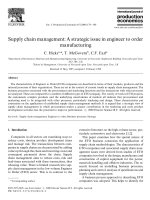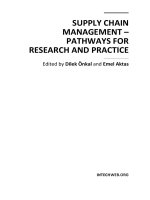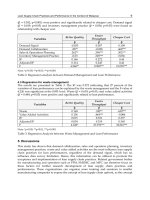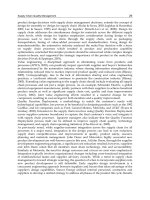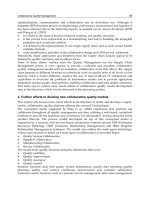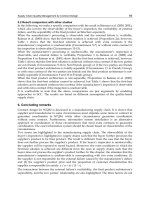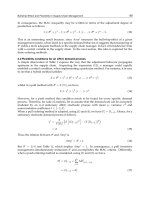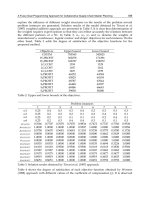Supply chain management A strategic issue in engineer to order manufacturing
Bạn đang xem bản rút gọn của tài liệu. Xem và tải ngay bản đầy đủ của tài liệu tại đây (172.39 KB, 12 trang )
Int. J. Production Economics 65 (2000) 179 } 190
Supply chain management: A strategic issue in engineer to order
manufacturing
C. Hicks
*, T. McGovern
, C.F. Earl
Department of Mechanical, Materials and Manufacturing Engineering, University of Newcastle, Stephenson Building, Newcastle upon Tyne,
NE1 7RU, UK
School of Management, University of Newcastle upon Tyne, Newcastle upon Tyne, UK
Received 13 May 1997; accepted 1 February 1999
Abstract
The characteristics of Engineer to Order (ETO) companies are described in terms of their markets, products and the
internal processes of their organisation. These are set in the context of current trends in supply chain management. The
business processes associated with the procurement and marketing functions and the interactions with other processes
are analysed. These are compared for a number of di!erent types of ETO company. The variety of work in ETO projects,
the customised, complex products and the underlying uncertainties of markets all indicate that procurement and
marketing need to be integrated with other processes, particularly tendering and design. These characteristics put
constraints on the application of established supply chain management methods. It is argued that a strategic view of
supply chain management in which procurement makes a greater contribution in the tendering and early product
development activities has the potential to improve performance. 2000 Elsevier Science B.V. All rights reserved.
Keywords: Supply chain management; Engineer to order; Business processes; Strategy
1. Introduction
Companies in all sectors are examining ways to
reduce costs, shorten product development times
and manage risk. The transactions between com-
panies in supply chains are characterised by adding
value up through the chain and incurring costs (and
consequent payments) down the chain. Supply
chain management aims to reduce costs, risk and
lead-times associated with these transactions, thus
releasing value. There is limited research into sup-
ply chain management in the low-volume Engineer
to Order (ETO) sector. This is in contrast to the
* Corresponding author.
extensive literature on the high-volume sector, par-
ticularly automotive and electronics [1,2].
This paper examines how the special nature of
the ETO business constrains the application of
supply chain methodologies. The characteristics of
ETO companies and associated supply chain man-
agement issues were derived from studies of ETO
companies involved in the design, manufacture and
construction of capital equipment for the power,
materials handling and o!shore industries. The re-
search focused on modelling business processes,
planning and control, analysis of speci"cations and
supply chain management.
A business process approach to describing ETO
companies was adopted. This helps to identify the
0925-5273/00/$ - see front matter 2000 Elsevier Science B.V. All rights reserved.
PII: S 0 9 2 5 - 5 2 7 3 ( 9 9 ) 0 0 0 2 6 - 2
Table 1
Collaborating ETO companies and their products
Company Turnover Employees Products Typical order
(Cm)
Customisation Depth of
product
structure
A 200 800 Steam turbine-generators 50}300 High Deep
B 200 3500 Oil platforms 20}25 High Deep
C 75 400 Power station boilers 50 High Deep
D 125 100 Mechanical handling 20 High Deep
E 25 50 Mechanical handling 10 High Deep
F 25 100 Electronic control systems 3 High Medium
G 150 600 Switchgear 50}100 Low Medium
Company also project manages power station contracts. This business has a high level of outsourcing as the company only
manufactures turbine generators.
Customisation: Low } mainly standard products, Medium } customised options, High } engineer to order.
Depth of product structure: Shallow } 1 to 3 levels, Medium } 3 to 6 levels, Deep } '6 levels.
nature of relationships between customers and sup-
pliers. These are particularly complex in ETO busi-
nesses, which are involved in many di!erent types
of supplier relationships. A systems modelling ap-
proach to representing this complexity is reported
elsewhere [3]. The ways that internal organisation
and structure constrain the role of supply chain
management in ETO companies are considered.
The paper does not investigate in any detail the
consequent issues of supply chain relationships, but
rather identi"es the environment in which these
relationships are established and maintained. Pro-
curement decisions in ETO companies are analysed
from an operational and strategic perspective.
2. Description of ETO companies
The research was conducted in collaboration
with seven companies in the power generation,
high-integrity materials handling and o!shore sec-
tors. The main business activities of the companies
are the design, manufacture and construction of
capital equipment. A summary of the character-
istics of the collaborating companies and their
products is shown in Table 1.
Companies A, B, D and G are the largest in terms
of turnover and number of employees. For all the
companies except company F, each order is a large
proportion of annual turnover and is therefore of
strategic importance. A}F are ETO companies that
supply highly customised products to meet indi-
vidual customer requirements. Company G has
high value orders but these are typically for over 10
units. It has a standardised range of products that
are con"gured to meet a broad range of national
and international electrical distribution require-
ments. They are supplied on a make to order basis.
Companies A}E produce products with complex
and deep product structures whilst companies
F and G produce less complicated items with
a shallower product structure.
A summary of the collaborating companies and
their business processes is provided in Table 2. All
of the companies have design and project manage-
ment capabilities. These are considered to be core
competencies in all cases. Companies A}D also
perform manufacturing, factory-based assembly,
construction and commissioning at customers'
sites. Company E produces similar products to
company D but is much smaller in terms of turn-
over and numbers employed. It only has a design
and project management capability as all other
activities are outsourced. Company F produces
electronic control systems, which are designed to
meet individual customer requirements and are as-
sembled from generic electronic components. The
company installs and commissions its equipment at
customers' sites. Company G has a strong design
capability, but in general, products are developed
180 C. Hicks et al. / Int. J. Production Economics 65 (2000) 179 }190
Table 2
Processes in collaborating companies
Company Processes Manufacturing
processes
Vertical
integration
A DPMACC JBFA High
B DPMACC JBA High
C DPMACC JBA High
D DPMACC JBA Medium
E DP None Low
F DPACC A Low
G DPMACC JBA High
Processes: D } design, P } project management, M } manufac-
turing, A } assembly, CC } construction and commissioning.
Manufacturing processes:J} jobbing, B } batch, F }#ow,
A } assembly.
Table 3
Supply chain management in collaborating companies
Company Outsourcing Supplier base Strategic
alliances
Partnership
agreements
Single
sourcing
agreements
A Extensive Reduced Yes Some No
B Extensive Reduced Yes Yes No
C Extensive Reduced No No No
D Extensive Diverse No No No
E All physical processes Diverse No No No
F All manufacturing Diverse No No No
G Extensive Reduced No No No
to meet the requirements of regional markets rather
than individual customers. The company has a wide
range of manufacturing and assembly processes and
installs and commissions its equipment on site.
Company A has the widest range of manufactur-
ing capability which includes jobbing, batch, #ow
and assembly processes and a wide range of manu-
facturing technologies. Fabrication of complex
structures is the main manufacturing activity for
companies B and C. This involves jobbing, batch
and assembly processes. Company D has a signi"-
cant fabrication capability, but it also produces
a wide range of mechanical components. It has
a range of jobbing, batch and assembly processes.
Company F does not manufacture components
and only performs assembly activities. Finally,
company G has a wide range of manufacturing
technologies ranging from steel pressing through
to electrical assembly and testing. These include
jobbing, batch and assembly processes.
The level of vertical integration and outsourcing
varies considerably within this group of companies.
It can be seen that companies A, B, C and G are
highly vertically integrated with substantial manu-
facturing capabilities. These companies manufac-
ture most of their products in-house, but outsource
standard components and systems. The level of
outsourcing is greater for company B as it produces
structural components but outsources all mechan-
ical systems. Company D, although having some
manufacturing capability, is less vertically integ-
rated than companies A, B and C. It is, therefore,
more dependent upon outsourced items. Com-
panies E and F are not vertically integrated and are
therefore more dependent upon their suppliers.
Table 3 shows some of the characteristics of
supply chain management in the collaborating
companies. It can be seen that all of the companies
are highly dependent upon outsourcing. This is
particularly so for company E which outsources all
of its physical activities and company F that only
performs assembly, construction and commission-
ing activities. Companies A}C and G have reduced
their supplier base whereas companies D, E and
F still have a large number of suppliers. Companies
A and B have established strategic alliances with
their customers and suppliers. Company B, in par-
ticular, has derived substantial competitive advant-
age from this approach. Only companies A and B
have formal partnership agreements with their sup-
pliers, but these are not single sourcing agreements.
C. Hicks et al. / Int. J. Production Economics 65 (2000) 179 }190 181
The ETO sector encompasses many types of com-
pany, designing and manufacturing a diverse range
of products. Individual products are generally highly
customised to meet individual customer require-
ments and are produced in low volume on an engin-
eer, or make to order basis. The main products have
deep and complex product structures that give rise
to many levels of assembly process. They contain
a diversity of components, some of which are re-
quired in very low volume, whereas others are re-
quired in medium or large quantities. Certain
components and systems are highly customised
whilst others are standardised. Some components
such as the control systems are technologically ad-
vanced whereas other items such as structural steel-
work are not. In general, high levels of customisation
lead to increased costs, higher risks and long lead-
times. It also makes outsourcing more di$cult as
component and subsystems requirements are only
fully speci"ed after the design process has taken
place. Most of the companies have recognised these
di$culties and are trying to increase design standar-
disation based upon modular design principles. In
many cases, this approach has proved di$cult due
to diverse customer requirements. Many designers
also have a strong desire to produce creative cus-
tomised solutions.
3. Business processes in ETO companies
For the purposes of describing the business pro-
cesses within ETO companies we decompose the
complex processes of interaction with customers
and suppliers into three stages. The "rst stage is
marketing, which is a two-way process that devel-
ops potential customers' awareness of the company
and its products. It provides an opportunity for the
ETO company to identify market trends, technical
and non-technical customer requirements, as well
as the customer's criteria for assessing competing
o!ers. It is based upon relationship marketing [4].
Decisions on whether an invitation to tender is
worth responding to are made at this stage. These
are based upon an assessment of customer require-
ments, commercial factors, the company's ability to
compete and the likelihood of success. Where the
markets for major products are in decline, the
marketing activity may include identifying new
business opportunities that can be exploited using
existing expertise and resources. Over the last dec-
ade, the nature and signi"cance of the marketing
function has changed in the collaborating com-
panies. It is now strategic. The privatisation of the
electricity supply industry has transformed the
competitive environment for companies A, C,
F and G. The decline in the oil price, the shift
towards smaller oil "elds, and the globalisation of
the industry has had a similar e!ect on company B.
The second stage is the response to an invitation
to tender for a particular contract. The tender in-
volves the preliminary development of the concep-
tual design and the de"nition of major components
and systems. Contact with selected suppliers is
made at this stage to obtain information on costs
and lead-times. There are often a number of phases
of negotiation with suppliers that aim to match
overall project cost and lead-time with anticipated
customer and market requirements. A technical
speci"cation, delivery terms, price and commercial
terms are agreed at this stage. This represents a
major commitment. Success requires a detailed
understanding of customer needs including tech-
nical features, price, delivery and quality require-
ments. This would imply the need for a strategy
based upon customer intimacy [5]. Konijnendijk
[6] reported that the tendering success rate is often
less than 30%. Research with our collaborating
companies indicates that the strike rate is often
lower.
The third stage takes place after a contract has
been awarded. Initial activities are non-physical [7]
including the development of an overall project
plan and detailed design. This is followed by pro-
curement, then the physical processes associated
with component manufacturing, assembly,
construction and commissioning. The level of
involvement by the company itself in these physical
activities varies from company to company and is
dependent on the level of vertical integration. As in
other sectors, ETO companies are reducing the
degree of vertical integration as they increasingly
rely on outsourcing [8]. The interaction of pro-
cesses within these three stages will emerge as an
important aspect of our analysis of supply chain
management.
182 C. Hicks et al. / Int. J. Production Economics 65 (2000) 179 }190
ETO companies respond to their markets in
unique ways [6]. The product range is mostly
based upon previous orders. Product innovation
may be general, such as developing an underlying
technology, or it may be speci"c to meeting the
requirements of a particular customer or order.
Medium- and long-term planning is usually based
upon aggregated information expressed in terms of
value or labour content. Typically a yearly sales
plan co-ordinates marketing and manufacturing
requirements. Decisions to outsource manufacture
are often taken at this level. Delivery dates in ten-
ders are based on lead-time estimates. These are
usually produced without information on available
capacity, as it is common for there to be several
`#oatinga quotations awaiting responses from
potential customers. Detailed speci"cations that
determine work content and duration are also
uncertain at this stage. It is, therefore, necessary to
reconsider the lead-times and delivery dates at the
order acceptance stage and to con"rm arrange-
ments with the customer. It may also be necessary
to review outsourcing decisions at this stage.
A key competitive factor in ETO markets is
delivery performance. Improving performance has
two components: reducing lead-time and increasing
the reliability of lead-time estimates. Lead-time re-
duction has been achieved by shortening the dura-
tion of individual processes and by increasing the
overlapping of previously sequential activities. Im-
provements in technology such as the application
of large multifunction machine tools can reduce
process times and improve dimensional accuracy.
This in turn reduces assembly times and their varia-
bility. Improvements in software support including
computer aided manufacturing (CAM), computer
aided production management (CAPM) systems,
computer aided design (CAD) enable faster
response, better planning and facilitate product
innovation. Concurrent engineering methods pro-
mote design for manufacturing and assembly as
well as the overlapping of these activities. Unex-
pected redesign and unnecessarily complex manu-
facture are avoided, thus giving more reliable lead-
time estimates. Delivery performance can also be
improved by streamlining products and processes
through modularity and standardisation. This may
be driven by the customer seeking familiar product
features and a minimum diversity of spare parts,
or by the supplier's desire to minimise costs and
complexity.
The ETO sector is characterised by a large
design content per order, the types of products
produced, the business processes and the nature of
the markets. Before proceeding to discuss how
these a!ect supply chain management in ETO com-
panies, di!erent approaches to vertical integration
within the sector are considered. Vertical integra-
tion is particularly relevant as it is a variable feature
in ETO organisations and a!ects the level and type
of outsourcing.
4. Vertical integration
The research undertaken has shown that ETO
companies can be classi"ed according to the level of
vertical integration. They span a continuum from
in-house manufacture of all components and as-
semblies at one extreme, to a pure design and
contract organisation at the other. Furthermore,
two types of design and contract business can be
identi"ed. In the "rst type, all items from suppliers
are delivered to site and the ETO company carries
out the construction and commissioning phase of
the work. In the second type, all physical activities
are undertaken by either suppliers or subcontrac-
tors. Only marketing, design, procurement and
project management are performed internally.
In considering the appropriate level of vertical
integration, ETO companies seek an optimum
response to a number of factors. These include:
reconciling customer delivery times with available
capacity; reducing costs; the availability of capital
for investment in equipment; potential utilisation of
plant; internal and external capabilities and #exibil-
ity. These factors vary from "rm to "rm giving rise
to di!ering levels of vertical integration. This varia-
bility makes it di$cult to prescribe best practice for
supply chain management in ETO companies. Our
observations on ETO companies suggest that there
has been a trend towards vertical disintegration
driven by "nancial pressures and the need for cost
reduction. Vertical disintegration can increase #ex-
ibility by making alternative product con"gura-
tions possible, but it can also reduce the scope of
C. Hicks et al. / Int. J. Production Economics 65 (2000) 179 }190 183
